给一个答复审稿人意见的coverletter
cover letter写作模板nano research -回复
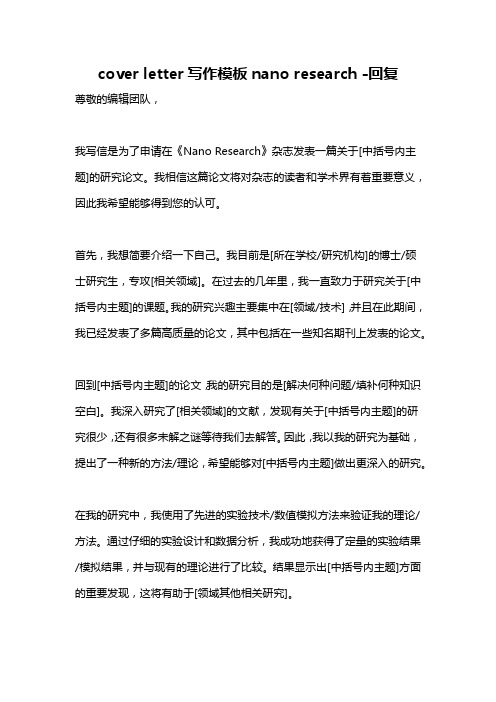
cover letter写作模板nano research -回复尊敬的编辑团队,我写信是为了申请在《Nano Research》杂志发表一篇关于[中括号内主题]的研究论文。
我相信这篇论文将对杂志的读者和学术界有着重要意义,因此我希望能够得到您的认可。
首先,我想简要介绍一下自己。
我目前是[所在学校/研究机构]的博士/硕士研究生,专攻[相关领域]。
在过去的几年里,我一直致力于研究关于[中括号内主题]的课题。
我的研究兴趣主要集中在[领域/技术],并且在此期间,我已经发表了多篇高质量的论文,其中包括在一些知名期刊上发表的论文。
回到[中括号内主题]的论文,我的研究目的是[解决何种问题/填补何种知识空白]。
我深入研究了[相关领域]的文献,发现有关于[中括号内主题]的研究很少,还有很多未解之谜等待我们去解答。
因此,我以我的研究为基础,提出了一种新的方法/理论,希望能够对[中括号内主题]做出更深入的研究。
在我的研究中,我使用了先进的实验技术/数值模拟方法来验证我的理论/方法。
通过仔细的实验设计和数据分析,我成功地获得了定量的实验结果/模拟结果,并与现有的理论进行了比较。
结果显示出[中括号内主题]方面的重要发现,这将有助于[领域其他相关研究]。
我相信,这篇论文将对广大读者产生重要的影响。
首先,它填补了[中括号内主题]的知识空白,为该领域的研究提供了新的思路和方向。
其次,我所提出的理论/方法具有广泛的应用前景,有望在[相关应用领域]中产生重大影响。
与此同时,论文中呈现的实验结果/模拟结果可为其他研究者提供可靠的实验数据和比较对象,推动领域的发展。
最后,我希望能够将这篇论文放在《Nano Research》杂志上发表。
我选择这个杂志是因为它是一个非常受学术界重视的期刊,以其高质量和广泛的影响力而闻名。
我深信,将我的论文发表在这个杂志上能够保证其被广泛传播和引用,从而为我的研究工作增添更多的价值。
我希望编辑团队能够给予我的论文仔细的审阅,并希望能够得到您认可并接受我的投稿。
sci 投稿cover letter写作模板

sci 投稿cover letter写作模板尊敬的SCI杂志编辑:
我谨提交我研究团队的最新论文,题目为《XXX》。
我们深信这篇论文将为贵刊的读者带来新的视角和启发,希望能够得到您的审阅和考虑。
我们的研究主要围绕XXX展开,经过长时间的实验和数据分析,我们得出了令人振奋的结果。
通过本研究,我们不仅深化了对XXX的理解,同时也为相关领域的未来研究提供了有益的参考。
我们选择将这篇论文提交给贵刊,是因为我们深知贵刊在该领域的权威和影响力。
我们期待着能够借助贵刊的平台,与广大同行分享我们的研究成果,并为学术界的发展贡献自己的力量。
在此,我代表全体作者感谢您对我们论文的重视和关注。
我们将非常乐意听取您的意见和建议,希望能够与您携手共同推动学术研究的进步。
再次感谢您抽出时间来审阅我们的论文,期待早日收到您的回复。
谢谢!
此致
作者:XXX
XXX大学
日期:XXXX年XX月XX日。
SCI的coverletter催稿信修稿回复
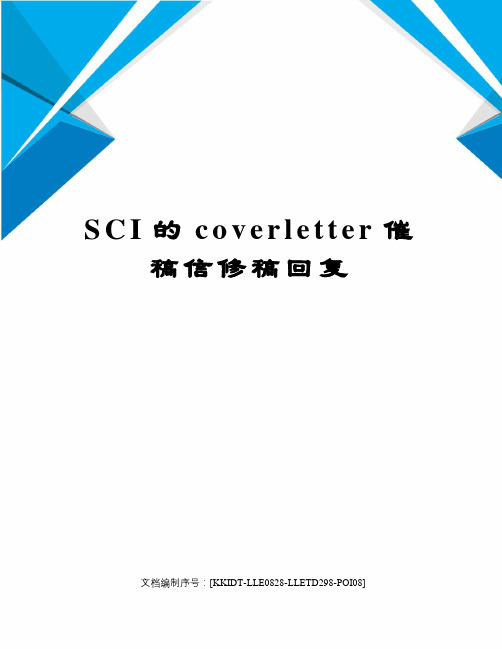
S C I的c o v e r l e t t e r催稿信修稿回复文档编制序号:[KKIDT-LLE0828-LLETD298-POI08]一、最初投稿Cover letterDear Editors:We would like to submit the enclosed manuscript entitled “Paper Title”, which we wish to be considered for publication in “Journal Name”. No conflict of interest exits in the submission of this manuscript, and manuscript is approved by all authors for publication. I would like to declare on behalf of my co-authors that the work described was original research that has not been published previously, and not under consideration for publication elsewhere, in whole or in part. All the authors listed have approved the manuscript that is enclosed.In this work, we evaluated …… (简要介绍一下论文的创新性). I hope this paper is suitable for “Journal Name”.The following is a list of possible reviewers for your consideration:1) Name A E-mail: ××××@××××2) Name B E-mail: ××××@××××We deeply appreciate your consideration of our manuscript, and we look forward to receiving comments from the reviewers. If you have any queries, please don’t hesitate to contact me at the address below.Thank you and best regards.Yours sincerely,××××××Corresponding author:?Name: ×××E-mail: ××××@××××二、催稿信Dear Prof. ×××:Sorry for disturbing you. I am not sure if it is the right time to contact you to inquire about the status of my submitted manuscript titled “Paper Title”. (ID: 文章稿号), although the status of “With Editor” has been lasting for more than two months, since submitted to journal three months ago. I am just wondering that my manuscript has been sent to reviewers or not?I would be greatly appreciated if you could spend some of your time check the status for us. I am very pleased to hear from you on the reviewer’s comments.Thank you very much for your consideration.Best regards!?Yours sincerely,××××××Corresponding author:?Name: ×××E-mail: ××××@××××Dear Editor, I'm not sure if it is the right time to contact you to inquire about the status of my submit ted manuscript which is submitted on Jun 24. The manuscript number is “SERREV-D-14-00023” and title is “Prediction and Structural Analysis of Impact Factor for Journals Indexed in SCI: A Case Study of Nature”. I have not yet received a reply and am wonder ing whether you have reached a decision. I would be greatly appreciated if you could spend some of your time check the status for me. With best regards Sincerely yoursSCI投稿---稿件状态咨询信四个范例范例一(推荐):邮件标题:Inquire about the status of manuscript (No: XXXX)正文:Dear Editor,Sorry for disturbing you.I'm not sure if it is the right time to contact you to inquire about the status of my submitted manuscript titled "XXXX" (ID: XXXX) although the status of "QUEUED FOR REVIEW" for my manuscript have been lasting for XXXX months.I am just wondering that my manuscript has been send to reviewers or notI am very pleased to hear from you. Thank you very much for your consideration.Yours sincerely,XXXE-mail: xxx@xxxx范例二:Dear Editor,It has been 4 months since we submitted our manuscript(ID:je-2008-00649n)to the journal office. I write this email to ask whether our paper has been accepted. And if is still being reviewed, when can I get the information of the final resultI would very much appreciate you if you could afford a little time to answer these question.Thank a lot!XXXX范例三:Dear Editor,I'm the first author of the article (No. ********) submitted to your journal about 3 months ago. I'm sorry writing to you to ask about its review progress. Many thanks and looking forward for your reply!Best wishes!Yours sincerely,*******范例四:Dear editor,Paper No.: ***Paper Title: ***We submitted the paper three months ago. Could you give us update information on the current status of our submission If there is anything that we can do, please let us know. Any information will be greatly appreciated. Thank you very much for your time.Yours sincerelyXXXX三、修改稿Cover letterDear Dr/ Prof..(写上负责你文章编辑的姓名,显得尊重,因为第一次的投稿不知道具体负责的编辑,只能用通用的Editors):On behalf of my co-authors, we thank you very much for giving us an opportunity to revise our manuscript, we appreciate editor and reviewers very much for their positive and constructive comments and suggestions on our manuscript entitled “Paper Title”. (ID: 文章稿号).We have studied reviewer’s comments carefully and have made revision which marked in red in the paper. We have tried our best to revise our manuscript according to the comments. Attached please find the revised version, which we would like to submit for your kind consideration.We would like to express our great appreciation to you and reviewers for comments on our paper. Looking forward to hearing from you.Thank you and best regards.Yours sincerely,××××××Corresponding author:Name: ×××E-mail: ××××@××××四、修改稿回答人的意见(最重要的部分)List of ResponsesDear Editors and Reviewers:Thank you for your letter and for the reviewers’ comments concerning our manuscript entitled “Paper Title” (ID: 文章稿号). Those comments are all valuable and very helpful for revising and improving our paper, as well as the important guiding significance to our researches. We have studied comments carefully and have made correction which we hope meet with approval. Revised portion are marked in red in the paper. The main corrections in the paper and the responds to the reviewer’s comments are as flowing:Responds to the reviewer’s comments:Reviewer #1:?1. Response to comment: (……简要列出意见……)Response: ××××××2. Response to comment: (……简要列出意见……)Response: ××××××。
英文COVERLETTER的多个模版和实例
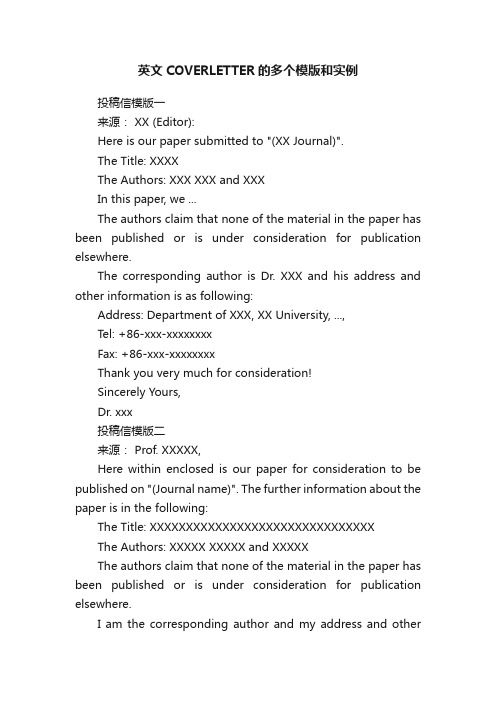
英文COVERLETTER的多个模版和实例投稿信模版一来源: XX (Editor):Here is our paper submitted to "(XX Journal)".The Title: XXXXThe Authors: XXX XXX and XXXIn this paper, we ...The authors claim that none of the material in the paper has been published or is under consideration for publication elsewhere.The corresponding author is Dr. XXX and his address and other information is as following:Address: Department of XXX, XX University, ...,Tel: +86-xxx-xxxxxxxxFax: +86-xxx-xxxxxxxxThank you very much for consideration!Sincerely Yours,Dr. xxx投稿信模版二来源: Prof. XXXXX,Here within enclosed is our paper for consideration to be published on "(Journal name)". The further information about the paper is in the following:The Title: XXXXXXXXXXXXXXXXXXXXXXXXXXXXXXXThe Authors: XXXXX XXXXX and XXXXXThe authors claim that none of the material in the paper has been published or is under consideration for publication elsewhere.I am the corresponding author and my address and otherinformation is as follows,Address: Department of XXXXXXXXX, Tsinghua University,Beijing, 10084,Tel: 86-Fax: 86-Thank you very much for consideration!Sincerely Yours,Dr. XXXXXXXXXXX投稿信模版三来源:(1)Dear Mr. **1. The work described has not been submitted elsewhere for publication, in whole or in part, and all the authors listed have approved the manuscript that is enclosed.2. I have read and have abided by the statement of ethical standards for manuscripts submitted to Neuroscience.kind regards.Your sincerely,通讯作者(2)Dear Dr. 主编name:We submit our manuscript entitled " 文章title" to 杂志名for publication.接着简单介绍你文章的主要创新点和意义,不易过多,但要突出新意和关键点。
cover letter写作模板nano research -回复

cover letter写作模板nano research -回复尊敬的Nano Research,我非常高兴能有机会向贵刊提交我们团队的研究成果。
以下是关于我们研究的详细信息以及提交给贵刊的原因。
1. 研究背景和目的:[在此为您介绍研究的背景和目的。
请说明研究领域和问题的重要性,以及你们研究的具体目的和动机。
]2. 研究方法:[在此介绍你们的研究方法。
请详细描述实验设计、数据采集、分析方法等。
]3. 研究结果和讨论:[在此介绍你们的研究结果和讨论。
请具体说明实验结果,提供数据和图表支持。
也请解释你们对结果的解读,并与现有研究进行比对和讨论。
]4. 创新点和贡献:[在此阐述你们的研究创新点和对学术界的贡献。
请指出你们研究与现有文献的不同之处,并具体解释为什么这种创新对该领域的发展很重要。
]5. 指导意见和潜在审稿人:[在此,可以提出一些建议,以指导审稿人在审稿时关注哪些方面。
另外,如果您对可能的审稿人有任何建议或要求,请在这里表明。
]6. 参考文献:[在此列出参考文献,确保符合贵刊的引用要求。
]我们选择向Nano Research提交这篇研究成果,是因为我们相信贵刊具有出色的学术声誉和权威性。
贵刊的编辑和审稿人对于投稿的要求严格,能够保证研究质量和学术水平的高标准,这与我们研究的目标一致。
此外,贵刊拥有广泛的读者基础和国际化的影响力,我们希望通过贵刊的发表来与相关领域的研究学者进行交流和合作。
感谢您抽出时间阅读我们的研究成果。
我们期待着与贵刊的编辑和审稿人一起合作,共同推进该领域的研究进展。
谢谢!此致XXX(您的名字)参考文献:1. 参考文献2. 参考文献3. 参考文献。
decision letter cover letter -回复

decision letter cover letter -回复尊敬的[收件人姓名],首先,我想向您表示我对您提交给我们的文件的感谢和关注。
我们非常重视您对我们公司/机构的兴趣和申请,并且很高兴能有机会仔细审阅您的材料。
您投递的文件中包含了神秘的中括号内容,让我猜测这封信的主题应该是关于[decision letter cover letter]。
我要向您致以最诚挚的祝贺和表扬,因为您已经迈出了一大步,向我们递交了您的决定信封。
这说明您对我们的公司/机构怀有强烈的兴趣,并且您期待着我们对您的申请做出积极的回应。
接下来,我将向您解释[decision letter cover letter]的定义和重要性。
决定信封附信通常是申请人在收到录取或拒绝通知后写给招聘方的一封回信。
这封信是向招聘方表达感谢,并对已做出的决定表示回应的一种方式。
决定信封附信能够展示申请人的职业素养和礼貌,并且反映了他们对招聘方对自己进行考虑的重视。
在撰写决定信封附信时,有几个关键要点值得注意。
首先是表达感谢之情。
不论您是否收到了录取通知,都要向招聘方表示感激,尊重对您的考虑和投入的时间和精力。
其次是对决定本身进行回应。
如果您收到了录取通知,您可以表达您对这个机会的期待,并表示您愿意认真履行您的职责。
如果您收到了拒绝通知,您也要以礼貌和诚挚的态度表示理解和接受决定,并对招聘方的机会向他们表达感激之情。
最后,要保持专业。
确保您的附信简洁明了、格式正确,并遵循商业信函的基本规范,如对称的布局、正式的语气和正确的称谓。
当您准备写决定信封附信时,有一些例句和提示可能对您有所帮助。
例如,您可以写:“我非常感谢您给予我这个机会,并对XXX的录取表示衷心的感激。
”或者,“非常感谢您对我申请的审阅和考虑,我对XXX的职位非常感兴趣,因此我将非常高兴地接受这个机会。
”如果您收到了拒绝的通知,您可以写:“尽管我不幸没有被选中,但我对您和您的团队以及XXX公司/机构表示最真挚的感谢。
SCI的coverletter催稿信修稿回复

一、最初投稿Cover letterDear Editors:We would like to submit the enclosed manuscript entitled “Paper Title”, which we wish to be considered for publication in “Journal Name”. No conflict of interest exits in the submission of this manuscript, and manuscript is approved by all authors for publication. I would like to declare on behalf of my co-authors that the work described was original research that has not been published previously, and not under consideration for publication elsewhere, in whole or in part. All the authors listed have approved the manuscript that is enclosed.In this work, we evaluated ……简要介绍一下论文的创新性. I hope this paper is suitable for “Journal Name”.The following is a list of possible reviewers for your consideration:1 Name A E-mail: ××××××××2 Name B E-mail: ××××××××We deeply appreciate your consideration of our manuscript, and we look forward to receiving comments from the reviewers. If you have any queries, please don’t hesitate to contact me at the address below.Thank you and best regards.Yours sincerely,××××××Corresponding author:Name: ×××E-mail: ××××××××二、催稿信Dear Prof. ×××:Sorry for disturbing you. I am not sure if it is the right time to contact you to inquire about the status of my submitted manuscript titled “Paper Title”. ID: 文章稿号, although the status of “With Editor”has been lasting for more than two months, since submitted to journal three months ago. I am just wondering that my manuscript has been sent to reviewers or notI would be greatly appreciated if you could spend some of your time check the status for us. I am very pleased to hear from you on the reviewer’s comments.Thank you very much for your consideration.Best regardsYours sincerely,××××××Corresponding author:Name: ×××E-mail: ××××××××Dear Editor, I'm not sure if it is the right time to contact you to inquire about the status of my submitted manuscript which is submitted on Jun 24. The manuscript number is “SERREV-D-14-00023” and title is “Prediction and Structural Analysis of Impact Factor for Journ als Indexed in SCI: A Case Study of Nature”. I have not yet received a reply and am wondering whether you have reached a decision. I would be greatly appreciated if you could spend some of your time check the status for me. With best regards Sincerely yoursSCI投稿---稿件状态咨询信四个范例范例一推荐:邮件标题:Inquire about the status of manuscript No: XXXX正文:Dear Editor,Sorry for disturbing you.I'm not sure if it is the right time to contact you to inquire about the status of my submitted manuscript titled "XXXX" ID: XXXX although the status of "QUEUED FOR REVIEW" for my manuscript have been lasting for XXXX months.I am just wondering that my manuscript has been send to reviewers or notI am very pleased to hear from you. Thank you very much for your consideration.Yours sincerely,XXXE-mail: xxxxxxx范例二:Dear Editor,It has been 4 months since we submitted our manuscriptID:je-2008-00649nto the journal office.I write this email to ask whether our paper has been accepted. And if is still being reviewed, when can I get the information of the final resultI would very much appreciate you if you could afford a little time to answer these question. Thank a lotXXXX范例三:Dear Editor,I'm the first author of the article No. submitted to your journal about 3 months ago. I'm sorry writing to you to ask about its review progress. Many thanks and looking forward for your replyBest wishesYours sincerely,范例四:Dear editor,Paper No.:Paper Title:We submitted the paper three months ago. Could you give us update information on the current status of our submission If there is anything that we can do, please let us know. Any information will be greatly appreciated. Thank you very much for your time.Yours sincerelyXXXX三、修改稿Cover letterDear Dr/ Prof..写上负责你文章编辑的姓名,显得尊重,因为第一次的投稿不知道具体负责的编辑,只能用通用的Editors:On behalf of my co-authors, we thank you very much for giving us an opportunity to revise our manuscript, we appreciate editor and reviewers very much for their positive and constructivecomments and suggestions on our manuscript entitled “Paper Title”. ID: 文章稿号.We have studied reviewer’s comments carefully and have made revision which marked in red in the paper. We have tried our best to revise our manuscript according to the comments. Attached please find the revised version, which we would like to submit for your kind consideration.We would like to express our great appreciation to you and reviewers for comments on our paper. Looking forward to hearing from you.Thank you and best regards.Yours sincerely,××××××Corresponding author:Name: ×××E-mail: ××××××××四、修改稿回答人的意见最重要的部分List of ResponsesDear Editors and Reviewers:Thank you for your letter and for the reviewers’comments concerning our manuscript entitled “Paper Title”ID: 文章稿号. Those comments are all valuable and very helpful for revising and improving our paper, as well as the important guiding significance to our researches. We have studied comments carefully and have made correction which we hope meet with approval. Revised portion are marked in red in the paper. The main corrections in the paper and the responds to the reviewer’s comments are as flowing:Responds to the reviewer’s comments:Reviewer 1:1. Response to comment: ……简要列出意见……Response: ××××××2. Response to comment: ……简要列出意见……Response: ××××××;;;;;;逐条意见回答,切忌一定不能有遗漏针对不同的问题有下列几个礼貌术语可适当用用:We are very sorry for our negligence of ……...We are very sorry for our incorrect writing ……...It is really true as Reviewer suggested that……We have made correction according to the Reviewer’s comments.We have re-written this part according to the Reviewer’s suggestionAs Reviewer suggested that……Considering the Reviewer’s suggestion, we have ……最后特意感谢一下这个审稿人的意见:Special thanks to you for your good comments.Reviewer 2:同上述Reviewer 3:××××××Other changes:1. Line 60-61, the statements of “……”were corrected as “…………”2. Line 107, “……”was added3. Line 129, “……”was deleted××××××We tried our best to improve the manuscript and made some changes in the manuscript.These changes will not influence the content and framework of the paper. And here we did not list the changes but marked in red in revised paper.We appreciate for Editors/Reviewers’warm work earnestly, and hope that the correction will meet with approval.Once again, thank you very much for your comments and suggestions.五、文章接受后可以考虑感谢一下负责你文章的编辑或主编根据需要Dear Prof. ××××××:Thanks very much for your kind work and consideration on publication of our paper. On behalf of my co-authors, we would like to express our great appreciation to editor and reviewers.Thank you and best regards.Yours sincerely,××××××Corresponding author:Name: ×××E-mail: ××××××××六、询问校稿信件如果文章接受后时间较长Dear ×××:Sorry for disturbing you. I am not sure if it is the right time to contact you to inquire about the status of our accepted manuscript titled “Paper Title”ID: 文章稿号, since the copyright agreement for publication has been sent to you two months ago. I am just wondering that how long I can receive the proof of our manuscript from youI would be greatly appreciated if you could spend some of your time for a reply. I am very pleased to hear from you.Thank you very much for your consideration.Yours sincerely,××××××Corresponding author:Name: ×××E-mail: ××××××××七、文章校稿信件Dear Mr. ×××:Thanks very much for your kind letter about the proof of our paper titled “Paper Title”ID: 文章稿号for publication in “Journal Name”. We have finished the proof reading and checking carefully, and some corrections about the proof and the answers to the queries are provided below.Corrections:1. In should be Page , Right column, line2. In the “”should be “”Page , Right column, lineAnswers for “author queries”:1. .2.3.We greatly appreciate the efficient, professional and rapid processing of our paper by your team. If there is anything else we should do, please do not hesitate to let us know.Thank you and best regards.Yours sincerely,××××××Corresponding author:Name: ×××E-mail: ××××××××。
cover letter 写作例句 -回复
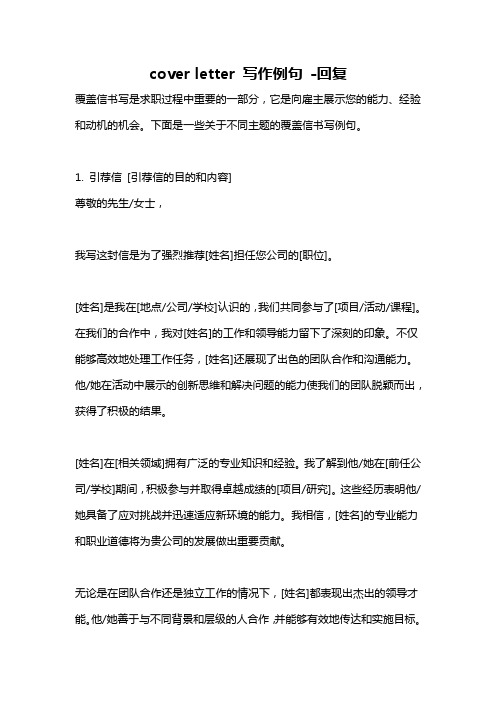
cover letter 写作例句-回复覆盖信书写是求职过程中重要的一部分,它是向雇主展示您的能力、经验和动机的机会。
下面是一些关于不同主题的覆盖信书写例句。
1. 引荐信[引荐信的目的和内容]尊敬的先生/女士,我写这封信是为了强烈推荐[姓名]担任您公司的[职位]。
[姓名]是我在[地点/公司/学校]认识的,我们共同参与了[项目/活动/课程]。
在我们的合作中,我对[姓名]的工作和领导能力留下了深刻的印象。
不仅能够高效地处理工作任务,[姓名]还展现了出色的团队合作和沟通能力。
他/她在活动中展示的创新思维和解决问题的能力使我们的团队脱颖而出,获得了积极的结果。
[姓名]在[相关领域]拥有广泛的专业知识和经验。
我了解到他/她在[前任公司/学校]期间,积极参与并取得卓越成绩的[项目/研究]。
这些经历表明他/她具备了应对挑战并迅速适应新环境的能力。
我相信,[姓名]的专业能力和职业道德将为贵公司的发展做出重要贡献。
无论是在团队合作还是独立工作的情况下,[姓名]都表现出杰出的领导才能。
他/她善于与不同背景和层级的人合作,并能够有效地传达和实施目标。
我目睹过他/她在压力下保持冷静、解决问题的能力,以及对工作细节和质量的高度关注。
这些品质使[姓名]成为有能力管理团队和项目的理想人选。
综上所述,我强烈推荐[姓名]担任贵公司的[职位]。
他/她具备丰富的专业知识和经验,热衷于工作并有追求卓越的激情。
[姓名]的领导能力和团队合作精神将为贵公司带来积极的成果。
如果您需要任何进一步的信息或有任何问题,请随时与我联系。
顺祝商祺,[您的名字]2. 自我介绍[介绍个人背景和技能]尊敬的先生/女士,我非常荣幸有机会向您介绍自己,并表达我加入贵公司的意愿。
我是[姓名],具备[相关领域]领域的专业知识和经验。
我在[学校/公司]获得了[学位/资格],并在[相关领域]工作了[工作年限]年。
通过这些经历,我发展了对[行业]的深入了解,并熟练掌握了[相关工具/技能]。
给一个答复审稿人意见的coverletter

给一个答复审稿人意见的coverletter,希望对大家有帮助Cover letterManuscript number: BXXXXXKMS Type: ArticleTitle: "XXXX"Correspondence Author: XXXDear Dr. Fay Riordan:Thank you very much for your attention and the referee’s evaluation and comments on our paper BXXXXK. We have revised the manuscript according to your kind advices and referee’s detailed suggestions. Enclosed please find the responses to the referees. We sincerely hope this manuscript will be finally acceptable to be published on XXX.Thank you very much for all your help and looking forward to hearing from you soon.Best regardsSincerely yoursDr. XXXPlease find the following Response to the comments of referees:Response to the referee’s commentsReferee AComment 1: The titania material formed after calcining at 450 oC is not characterized. XRD of these calcined materials should be provided to understand the crystallinity and phase.Response: Thanks for the referee’s kind suggestion. According to his/her advices, X-ray diffractometry spectroscopy (XRD) of the calcined TiO2 film was given in Supporting Information (Figure S1) in this revised version. It illustrated that the hydrothermal synthesized TiO2 materials after calcining at 450 oC is entire anatase, which was confirmed by the X-ray diffractometer with Cu Kα radiation (Rigaku D/ max-2500).Comment 2: The authors must state the mechanical strength of these materials after the removal of PS by calcinations.Response: Thanks for the referee’s suggestion. By a scotch tape peel test, the TiO2 film can’t be stripped from the conducting glass substrate, which indicates that the mechanical strength of as-prepared composite film is strong enough for the fabrication of solar cell devices. The revised details can be found in Line 165-168, page 2.Referee BComment 1: The microtube structure with the size of 500-800 nm cannot only scatter the visible light in the region of 500-800 nm, but also can scatter more efficiently the visible light in the region below 500 nm, and can scatter near infrared light. This point should be clarified in the main text.Response: Thanks for the referee’s kind advice. Just like what the referee said, the microtube network structure can scatter not only visible light but also near infrared light. We added this point in revised manuscript and the detailed revision can be found in Line 194-205, Page 2-3.Comment 2: They described the simulated sunlight as "one-simulating-sunlight condition (AM1.5, 100 mW cm-2)". But in my opinion, it would be better to use the phrase like "AM 1.5 simulated solar light (100 mW cm-2)".Response: Thanks for the referee’s suggestion. "one-simulating-sunlight condition (AM1.5, 100 mW cm-2)" has been changed to "AM 1.5 simulated solar light (100 mW cm-2)" in our revised manuscript. (Line 217, Page 3)Comment 3: They correctly pointed out that the increased ratio of solar energy conversion efficiency by the microtube-network structure was smaller than that estimated from the absorption spectra. It is understandable, considering that a TiO2 porous film was filled with solvent in a device, while that for spectroscopic measurements is filled with air.Response: Thanks for the referee’s good evaluation and kind suggestion. The referee’s explanation is very correct. Light absorptions of TiO2 photoelectrodes are different when they are filled with electrolytes and air, respectively. It is ascribed to that a part of solar light will be absorbed by the electrolytes and also different medium in the porous film will induce the different refractive indices. This is one reason that increased ratio of conversion efficiency by the microtube-network structure was smaller than that estimated from the absorption spectra. We added this point into our revised manuscript and the details can be found in Line 325-330, Page 4.【论坛浏览】【我来说两句】【打印】【大】【中】【小】【关闭】相关评论作者: hxszhy 发布日期: 2007-11-28这里还给一个在某论坛上看到的一个帖子,关于答复审稿人,只是供大家参考:很多人都遇到过回复审稿人意见的时候。
怎样写好国外期刊修改稿的CoverLetter

怎样写好国外期刊修改稿的CoverLetter怎样写好国外期刊修改稿的Cover LetterCover Letter是一篇文章的外衣,对国外投稿能否成功很关键,一般投稿时的Cover Letter并不是很重要,只要说明你稿件的研究方向及创新点,并声明没有在其他期刊发表过.最难写的就是Revised Manuscript中的Cover Letter,这将关系到是否录用你的稿件,或要进一步审稿.国外专家讲求的是精益求精,老外们对文章都很严谨的,一个单词哪怕是一个介词的使用都是很有考究的,因此会提出很多似乎对文章无关紧要的修改意见,但是这你要给予充分的重视.通过国外发表几篇文章后,开始一直失败,但是我没有放弃,通过总结现在将一些经验和大家分享,以免大家走很多不必要的弯路.为了更好理解,我用我发的一篇文章作为例子来说明:这里是期刊审稿人的修改意见:Dear *****,The review of your manuscript, Thermal Decomposition and Kinetics Studies on 1, 4-dinitropiperazine (DNP), submitted to Journal of Hazardous Materials has been completed. The reviewers recommend the need for minor revisions. Please revise your manuscript according to the reviewers' comments attached, and re-submit to me your revised version of the manuscript including an itemized response to each reviewer's comments.Please submit your revised submission before Jul 11, 2007. I will then begin the re-review process.Please note that revised manuscripts will be sent for review because revising a manuscript does not automatically mean it will be accepted for publication.For your guidance, reviewers' comments are appended below.On your Main Menu page is a folder entitled "Submissions Needing Revision". You will find your submission record there.Please ensure that the article conforms to the format of the Journal. In particular make sure that all the articles in your references have titles included. The Journal Guide for Authors is available on the Journal homepage [url]/locate/hazmat[/url]When submitting your revised manuscript, please ensure that you upload the source files (e.g. Word). Uploading a PDF file at this stage will create delays should your manuscript be finally accepted for publication. If your revised submission does not include the source files, we will contact you to request them.Once again, thank you for your interest in Journal of Hazardous Materials.Yours sincerely,Merv Fingas, PhDEditorJournal of Hazardous MaterialsReviewers' comments:Reviewer #1: The paper reports on the thermal decomposition and kinetics of DNP.It is a welcome addition to the literature and appectable forpublication after some revision:(i) Please provide large basis-set DFT calculations to support the assignment of the IR bands of DNP.(ii) Please assign ALL IR bands of Fig. 5Reviewer #2: authors have carried out work on the thermal analysis of the dinitropiperazine. The new information reported in the paper is scanty. The large amount of data has been already reported by the several researchers on the thermal analysis of dinitropiperazine (See the reference section of the paper and also reviewer has done the scopus search). The only new information reported in this paper is of the T-Jump IR studies and DSC studies under different pressures, which may adds on to the existing scientific data base. There is not much novelty in the reported work.The Table 1 and figure 1 need to be deleted from the paper since it is already well reported in the literature.Table 2 and figure 3 gives the same information. Authors are requested to delete Table 2 and the same information may be explained in the results and discussion part of the paper.May i also kindly request authors to update the literature survey till date on DNP in the introduction part of the paper using Chemical abstracts on disk (CA on CD) data base.The quality and clarity of the figures in the paper need to be improved.English need to be improved.The paper is recommended for short communication after the minor revision.Reviewer #3: The paper is okay in terms of contents.However,since it has been written bya Chinese, the english is very poor and as such requires a lot of corrections and editing by your team.The authors have used ozawa and Kissenger methods to find out activationenergy.However,they have given data for activation energy by ozawa methodonly under 3.4 thermal decomposition kinetics).The data for Eo by Kissenger methods shouldalso be included in the paper.Also,captions of Figs 1,3 &5 are missing.Reviewer #4: This paper is promising but could be improved by better kinetic analysis.1. Kissinger's method is OK as a first approximation, but Friedman's method is the best isoconversional method. Even Ozawa has abandoned his method in favor of Friedman's.2. The method of comparing a large number of kinetic models against data at a single heating rate (page 5) is invalid, discredited, and should not be published. This issue has been discussed in several papers by Vyzovkin and in a international kinetic study published by Brown et al, Thermochemica Acta 355, 125-143, 2000, and following papers. Consequently, there is noreal evidence presented that the equation is first-order. In fact, from my studies of energetic materials, including RDX and HMX, I would have thought that nucleation-growth kinetics would be most appropriate. However, I would have to do a more rigorous kinetic analysis of the data to know for sure.3. The best way to judge a kinetic model is how it compares with data at multiple heating rates (using a single set of parameters). Such a comparison is not present in this paper, so it is difficult to judge the validity of the kinetic parameters.4. The author's discussion of HMX kinetics is good in some respects but out of date in others. More recent papers by multiple institutions place the activation energy for HMX closer to 150 kJ/mol. A commonly cited paper on this is by Wight and Vyazovkin, Ann Rev Phys Chem 48, 119, 1997. A more recent but harder paper to get is by Burnham and Weese in the proceedings of the 2005 ICT conference. Henson has published a correlation in the detonation symposium showing that explosion times scale with an activation energy of about 150 kJ/mol. Active workers in energetic materials should have access to these materials.看完了这个,是不是会觉得很头疼,是的老外就是这么认真.要求很具体仔细,审稿细致深入.下面就是看你怎么样回复这篇审稿意见了.我回复后的第三天就收到论文录用通知,估计他们没有再次送给审稿专家重审.因为我的Cover Letter他很满意,我是这样写的:Dear ***,My manuscript, *********************(论文题目), was revised according to the reviewers' comments, and the itemizedresponse to each reviewer’s comments is attached. Many thanks for your suggestion. I am so sorry to bring you so much trouble because of our careless. Correspondence and phone calls about this paper should be directed to ****(作者)at the following address,phone and e-mail:Address: *********Tel.: ********Fax:*******E-mail: **********Thanks very much again for your attention to our paper.Once again, thank you for your help to our paper processing.Yours sincerely,******For your guidance, itemized response to each reviewer’s comments is appended below.Dear reviewer #1:(i) Suhithi M. Peiris, Richard, etc. (J. Phys. Chem. A, 104 (39), 8898 -8907, 2000. 10.1021) had already reported large basis-set DFT calculations to support the assignment of the IR bands of DNP.(ii) We assigned all IR bands of Fig.5 (now change to fig.8).(iii) Because of the IR study had been reported, the IR spectra (fig.1) was deleted form the paper. Anyway, thank you for your arduous work and instructive advice.Dear reviewer #2:(i) G. V. Sitonina, etc. (Russian Chemical Bulletin, Vol.28, 284-288) A study has been made of the kinetics of thermaldecomposition of dinitropiperazine, in melts and in solution. As you said, the only new information reported in this paper is of the T-Jump IR studies and DSC studies under different pressures, which may adds on to the existing scientific data base. Nevertheless, the kinetics study in our paper is a supplement which is with multi-heating rate method.(ii) The Table 1 and figure 1 was deleted from the paper and the correlative references were put forward.(iii) Table 2 was deleted and the same information was explained in the results and discussion part of the paper.(iv) We had update the literature survey till date on DNP in the introduction part of the paper and enriched the introduction of the paper.(v) The figures were drawn again and the quality and clarity of them were improved.(vi) English expression w as improved a little and it’s my great honor to ask your help on the language aspect.Dear reviewer #3:(i) As a Chinese, our English is very poor and a few of corrections and editing had done by our team.(ii) Now we only used Ozawa method to find out activation energy and you can check it in our paper again. According to reviewer #4, Kissinger method is invalid, discredited, and should not be published.(iii) Figures and captions of them are changed.(iv) At last, thank you for your arduous work and instructive advice.Dear reviewer #4:i. This paper was improved by a better kinetic analysis. The kinetic parameters were established by Ozawa's isoconversional method because there is no Friedman's calculation program in our institute.ii. As you just said, the method of comparing a large number of kinetic models against data at a single heating rate is invalid. After the kinetic study by isoconversional method with data at multiple heating rates, we found that nucleation-growth kinetics is more appropriate. You are seasoned in these aspects and it’s my great honor to ask your advice on these sorts of aspects.iii. In order to judge a kinetic model, we did a comparison a single heating rate method with multi-heating method, and at last the kinetic parameters were judged.iv. You are right; the discussion of HMX kinetics is really out of date. The activation energy for HMX is closer to 150 kJ/mol. We had done the improvements in our paper.v. From your comments, it’s obvious that you are an expert in thermo analysis, and there is lots of shortage in our study which need your instruction. At last, I want to thank you sincerely for your suggestions and I feel so sorry that so much of your precious time was wasted on our paper revision.这样的回复看似很复杂,其实这很有必要,你的回答一定要有条理并且要有针对性,针对每一个专家的意见分别做出自己的回应,其实这篇信也叫Response Letter. 这样一来,老外看出了你的一丝不苟,即使还有一些需要修正的小错误,他们也就不在乎了,自己帮你修正了.其实我们所处的专业不同,期刊的要求不同,专家的性格也不一样.但是总的来说就是四个字"一丝不苟",一定要认真对待修改意见.一般论文投到国外,如果满足期刊内容要求的前提下,一般会给你一个修改意见,不会直接拒绝.即使拒绝也是在第一次修改不满足要求的情况下拒绝的.他们想的是你改都改不好,还有什么话说.最后,我希望大家多多发表高质量的科技论文,多到国外投稿,这样不是为了多几篇SCI,是多增加国际交流,给自身的发展创造条件.特别是对于想出国深造的研究学者们.谨以此和大家共勉!本文多有论述不当之处,望大家批评指正!谢谢!。
中文投稿cover letter写作模板

中文投稿cover letter写作模板
中文投稿Cover Letter写作模板
尊敬的编辑部主任:
您好!我是XXX,是来自XXX大学的一名XXX专业的研究人员。
我很高兴向贵期刊提交我的论文,题目为《XXX》。
在此,我谨向您提供有关论文的简要信息和背景,以及我选择贵期刊投稿的原因。
本论文主要研究了XXX领域的XXX问题,通过XXX方法,得出了XXX结论。
我们认为这一研究对于推动XXX领域的发展具有重要的意义。
在撰写论文的过程中,我们充分考虑了贵期刊的办刊宗旨和学术水平,确保论文质量符合贵期刊的要求。
选择贵期刊投稿的原因有以下几点:首先,贵期刊在XXX领域享有很高的声誉,发表了许多高质量的学术论文,对于推动该领域的发展起到了重要的作用;其次,贵期刊的编辑团队具有丰富的专业知识和经验,能够为论文提供专业的指导和建议;最后,贵期刊的审稿流程严谨、公正,能够保证论文的学术水平和科学性。
在此,我谨代表全体作者向您表示衷心的感谢,并希望能够得到贵期刊的支持和认可。
如有任何问题或需要进一步的信息,请随时与我联系。
谢谢!
此致
敬礼!
XXX
XXXX年XX月XX日。
sci拒稿重投的cover letter模板 -回复
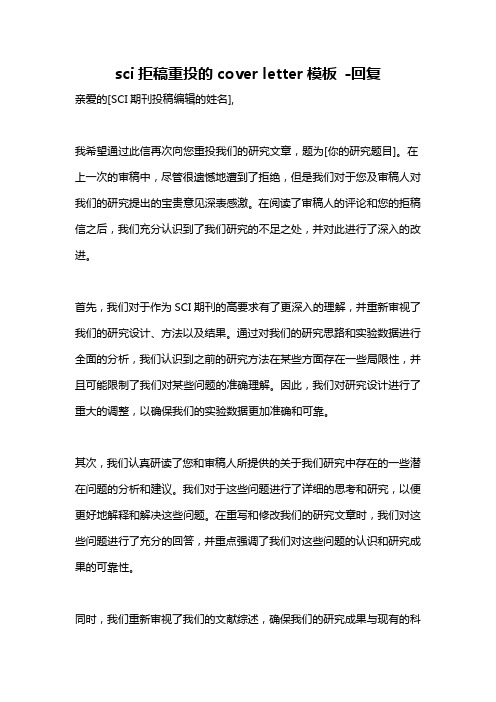
sci拒稿重投的cover letter模板-回复亲爱的[SCI期刊投稿编辑的姓名],我希望通过此信再次向您重投我们的研究文章,题为[你的研究题目]。
在上一次的审稿中,尽管很遗憾地遭到了拒绝,但是我们对于您及审稿人对我们的研究提出的宝贵意见深表感激。
在阅读了审稿人的评论和您的拒稿信之后,我们充分认识到了我们研究的不足之处,并对此进行了深入的改进。
首先,我们对于作为SCI期刊的高要求有了更深入的理解,并重新审视了我们的研究设计、方法以及结果。
通过对我们的研究思路和实验数据进行全面的分析,我们认识到之前的研究方法在某些方面存在一些局限性,并且可能限制了我们对某些问题的准确理解。
因此,我们对研究设计进行了重大的调整,以确保我们的实验数据更加准确和可靠。
其次,我们认真研读了您和审稿人所提供的关于我们研究中存在的一些潜在问题的分析和建议。
我们对于这些问题进行了详细的思考和研究,以便更好地解释和解决这些问题。
在重写和修改我们的研究文章时,我们对这些问题进行了充分的回答,并重点强调了我们对这些问题的认识和研究成果的可靠性。
同时,我们重新审视了我们的文献综述,确保我们的研究成果与现有的科学知识相一致,并避免了不准确或被引用的文献。
我们深入挖掘了相关文献,以提供更多的背景和支持我们的研究假设。
我们相信,我们对现有文献的全面回顾将增加我们的研究结果的可重复性和科学价值。
我们还对文章的结构和逻辑进行了重新组织,并加强了论述的清晰性和连贯性。
我们进一步完善了图表和实验数据的解释,以确保读者能够更好地理解我们的研究结果。
我们补充了一些额外的实验数据和对比分析,以支持我们的结论。
我们还扩展了对我们研究结果的潜在应用和未来研究方向的讨论,以便让读者更好地理解我们的研究的意义和价值。
最后,我们接受了审稿人的批评和建议,并感谢他们对我们研究的辛勤工作和付出。
我们承诺,在未来的研究中,我们将继续改进我们的实验设计和数据分析,以便提供更加准确和可靠的研究结果。
cover letter解释信 -回复

cover letter解释信-回复亲爱的招聘经理,我希望能够通过这封解释信来向您详细解释我在简历中提及的事项,并且进一步展示我对这个职位的兴趣和能力。
[中括号内容:缺乏相关工作经验]首先,我了解到在我的简历中可能缺少与这个职位直接相关的工作经验。
然而,我希望能够让您知道,尽管我没有直接相关的工作经验,但我在其他方面积累了一些宝贵的技能和经验,使我有能力胜任这个职位。
在我过去的工作经历中,我一直在非营利组织中担任志愿者工作,给予我机会与不同背景和需求的人们合作。
通过与团队合作并解决问题,我培养了良好的沟通能力和人际交往技巧。
此外,我还具备良好的组织能力和时间管理技巧,在工作中展示出高度的责任感和积极性。
除此之外,虽然我没有直接相关的工作经验,但我在相关领域的培训和教育方面投入了大量的时间和精力。
我参加了一些在线课程和实践工作坊,致力于学习和掌握与这个职位相关的技能和知识。
我相信这些学习机会为我提供了理论基础和实践经验,使我能够快速适应和学习新的工作环境。
[中括号内容:缺乏学历与资格]其次,我也了解到我可能没有理想的学历和资格对这个职位来说是必要的。
然而,我相信通过我的工作价值观和动力,我可以弥补这一点。
我一直秉持着终身学习的态度,并且不断努力提升自己的技能和知识。
而人对待科学的态度应该是积极的,持续学习是生活的基本要素之一。
我曾在过去数年里参加了一些非正式的学习计划,自学了许多与这个职位相关的课程和主题。
这些经历让我深信能够通过学习和实践来不断提高自己的能力。
此外,我也了解到这个职位可能对某些证书或执照有要求。
然而,我想强调的是,我具备学习、适应和实践这些要求的能力。
如果有机会加入贵公司,我愿意积极地努力学习并满足这些要求。
[中括号内容:职业转型]最后,我也想在这里明确说明我正在进行的职业转型。
我的过去经历可能与这个职位不太相关,但我对此充满了激情和动力。
我相信我可以通过我的才华、学习能力和努力工作,迅速适应并取得良好的表现。
coverletter优秀模板

coverletter优秀模板一份英文的求职信对于大家来说就有点棘手了。
下面小编搜集整了coverletter优秀模板给大家,欢迎阅读,供大家参考。
deardowhr,iamasophomoregraduatestudentinbeijinguniversityoftechn ology.andi’mwritinginresponsetoyouforrecruitingasalesandmar ketinginternpostedonyourpanywebsite.andibelievethatmystrong technicalexperienceandeducationwillmakemeaverypetitivecandi dateforthisposition.ihaveworkedtwoyearsonthedetectionofivingcreaturecausesy stem.duringthetwoyearsihadagoodviewonthedifferentapplicatio nsofbiotechnology,andtheforegroundofthebiotechnologyanden gineering.duringmymaster'stermmajoredinorganicchemistryihaveafullunderstandingofthechemicalengineering andcraft.andhaddeeperunderstandingonvariouschemicalapplica tions!themostconfidenceformetothisjobtitleishatihadworkedoney earthatfocusedonsalesofmedicineandchemistry.duringthisyearir ecognizemyexperienceincludesbutisnotlimitedto:customerservi ceandsupport·problemisolationandanalysis·applicationandrequirementanalysisthankyouforyourtimeandpatience,andiwouldgreatlyapprecia teitifyoucouldgrantmeaninterview.yourssincerely,hujieto:professor_____,editor-in-chief,xxxxxxjournalre:___etal.manuscript"____"deareditor(s),availableforyourreviewismanuscripttitled“__________________ _____________”.thepurposeofthisstudyis___________________________ __.basedontheseresults,wewouldliketodrawaconclusionthat______ ___________________.allauthorsofthispaperhavedirectlyparticipatedinthismanuscri pt.allauthorsofthispaperhavereadandapprovedthefinalversionsu bmitted.thecontentsofthismanuscripthavenotbeencopyrightedo rpublishedpreviously.thecontentsofthismanuscriptarenotunderc onsiderationforpublicationelsewhere.thecontentsofthismanuscri ptwillnotbecopyrighted,submitted,orpublishedelsewherewhileac ceptancebythemanuscriptisunderconsideration.therearenodirect lyrelatedmanuscriptsorabstracts,publishedorunpublished,byany author(s)ofthispaper.wethankyouforyourtimeandconsiderationofthismanuscript.sincerely,xxxx,m.d.拓展阅读:投稿coverletter模板大全1.第一次投稿coverletter:deareditors:wewouldliketosubmittheenclosedmanuscriptentitled“pape rtitle”,whichwewishtobeconsideredforpublicationin“journalna me”.noconflictofinterest exitsinthesubmissionofthismanuscript, andmanuscriptisapprovedbyallauthorsforpublication.iwouldliket odeclareonbehalfofmyco-authorsthattheworkdescribedwasoriginalresearchthathasnotbee npublishedpreviously,andnotunderconsiderationforpublicationel sewhere,inwholeorinpart.alltheauthorslistedhaveapprovedthema nuscriptthatisenclosed.inthiswork,weevaluated……(简要介绍一下论文的创新*).ihopethispaperissuitablefor“journalname”.thefollowingisalistofpossiblereviewersforyourconsideration:1)nameae-mail:××××@××××2)namebe-mail:××××@××××wedeeplyappreciateyourconsiderationofourmanuscript,and welookforwardtoreceivingmentsfromthereviewers.ifyouhaveany queries,pleasedon’thesitatetocontactmeattheaddressbelow.thankyouandbestregards.yourssincerely,××××××correspondingauthor:name:×××e-mail:××××@××××二、催稿信:询问稿件处理到声明步骤dearprof.×××:sorryfordisturbingyou.iamnotsureifitistherighttimetocontact youtoinquireaboutthestatusofmysubmittedmanuscripttitled“pa pertitle”.(id:文章稿号),althoughthestatusof“witheditor”hasbeenlastingformoreth antwomonths,sincesubmittedtojournalthreemonthsago.iamjust wonderingthatmymanuscripthasbeensenttoreviewersornot?iwouldbegreatlyappreciatedifyoucouldspendsomeofyourtim echeckthestatusforus.iamverypleasedtohearfromyouontherevie wer’sments.thankyouverymuchforyourconsideration.bestregards!yourssincerely,××××××correspondingauthor:name:×××e-mail:××××@××××三、修改稿coverletterdeardr/prof..(写上负责你文章编辑的姓名,显得尊重,因为第一次的投稿不知道具体负责的编辑,只能用通用的editors): onbehalfofmyco-authors,wethankyouverymuchforgivingusanopportunitytorevise ourmanuscript,weappreciateeditorandreviewersverymuchforthei rpositiveandconstructivementsandsuggestionsonourmanuscript entitled“papertitle”.(id:文章稿号).wehavestudiedreviewer’smentscarefullyandhavemaderevis ionwhichmarkedinredinthepaper.wehavetriedourbesttoreviseour manuscriptaccordingtothements.attachedpleasefindtherevisedv ersion,whichwewouldliketosubmitforyourkindconsideration.wewouldliketoexpressourgreatappreciationtoyouandreview ersformentsonourpaper.lookingforwardtohearingfromyou.thankyouandbestregards.yourssincerely,××××××correspondingauthor:name:×××e-mail:××××@××××四、修改稿回答审稿人的意见(最重要的部分)listofresponsesdeareditorsandreviewers:thankyouforyourletterandforthereviewers’mentsconcernin gourmanuscriptentitled“papertitle”(id:文章稿号).thosementsareallvaluableandveryhelpfulforrevisingandimpro vingourpaper,aswellastheimportantguidingsignificancetoourrese arches.wehavestudiedmentscarefullyandhavemadecorrectionwhi chwehopemeetwithapproval.revisedportionaremarkedinredinthepaper.themaincorrectionsinthepaperandtherespondstotherevie wer’smentsareasflowing:respondstothereviewer’sments:reviewer#1:1.responsetoment:(……简要列出意见……)response:××××××2.responsetoment:(……简要列出意见……)response:××××××。
sci拒稿重投的cover letter模板

尊敬的编辑委员会:我是XXX,来自XXX大学XXX研究团队的一名研究人员。
我想再次向您提交我们团队对于XXX方面的研究成果。
我理解您之前对我们提交的稿件所提出的拒稿意见,但经过我们团队的再次努力,我们已经对稿件进行了重大改进,并针对您提出的意见进行了深入的修改。
感谢您抽出宝贵的时间来审阅我们的稿件。
在此,我想就我们的研究成果重新提交给您,并就我们的研究成果向您进行较为详细的说明。
1. 研究背景:我国XXX方面的研究热点已经逐渐成为国际学术界关注的焦点。
在XXX的研究中,我们经过了XXX年的努力,已经取得了一系列的重要研究成果。
2. 研究内容:我们的研究主要集中在XXX方面的XXX,并在这一领域取得了重要的突破。
我们利用了XXX的研究方法,通过XXX的实验手段,对XXX进行了深入的探究,并取得了一系列重要的研究结果。
3. 研究意义:我们的研究成果对于XXX领域的进一步发展具有重要的理论和实践意义。
我们的研究成果在XXX方面具有重要的指导意义,并且对XXX的发展具有重要的推动作用。
4. 对于之前拒稿意见的回应:在您之前的拒稿意见中,您提出了XXX方面的意见。
我们在此针对您提出的每一条意见,进行了认真的修改。
我们相信,我们的修改可以符合您的审稿要求。
我们深信我们的研究成果符合贵刊的发表要求,我们诚恳地希望您能再次审阅我们的稿件,并给予我们一次发表的机会。
我们期待能够在贵刊上发表我们的研究成果,与广大学者共同交流,共同促进XXX领域的研究发展。
再次感谢您的审阅,期待您的回复。
此致敬礼XXX 敬上尊敬的编辑委员会:我是XXX,来自XXX大学XXX研究团队的一名研究人员。
非常感谢您在之前对我们提交的稿件进行审阅,并提供宝贵的意见。
经过我们团队的再次努力,我们对稿件进行了重大改进,并认真针对您的意见进行了深入的修改。
我们希望再次向您提交我们团队对于XXX方面的研究成果,期待能够在贵刊上发表我们的研究成果。
下面我将再次就我们的研究成果向您进行较为详细的介绍。
ieee 的cover letter 模板
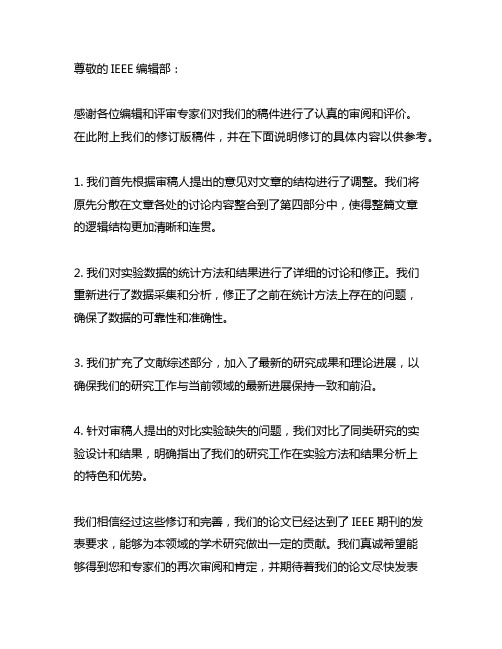
尊敬的IEEE编辑部:感谢各位编辑和评审专家们对我们的稿件进行了认真的审阅和评价。
在此附上我们的修订版稿件,并在下面说明修订的具体内容以供参考。
1. 我们首先根据审稿人提出的意见对文章的结构进行了调整。
我们将原先分散在文章各处的讨论内容整合到了第四部分中,使得整篇文章的逻辑结构更加清晰和连贯。
2. 我们对实验数据的统计方法和结果进行了详细的讨论和修正。
我们重新进行了数据采集和分析,修正了之前在统计方法上存在的问题,确保了数据的可靠性和准确性。
3. 我们扩充了文献综述部分,加入了最新的研究成果和理论进展,以确保我们的研究工作与当前领域的最新进展保持一致和前沿。
4. 针对审稿人提出的对比实验缺失的问题,我们对比了同类研究的实验设计和结果,明确指出了我们的研究工作在实验方法和结果分析上的特色和优势。
我们相信经过这些修订和完善,我们的论文已经达到了IEEE期刊的发表要求,能够为本领域的学术研究做出一定的贡献。
我们真诚希望能够得到您和专家们的再次审阅和肯定,并期待着我们的论文尽快发表在IEEE期刊上。
再次感谢您和专家们的辛勤工作和宝贵意见,期待您的回复。
此致敬礼作者:XXX单位:XXX日期:XXXX年XX月XX日尊敬的IEEE编辑部:在您和专家们的指导下,我们对我们的稿件进行了进一步的修改和完善,以期望能够使得我们的研究工作更加符合期刊的要求。
在修订的过程中,我们着重关注了审稿人提出的一些关键性问题并进行了针对性的改进和完善。
以下是我们最近的修订和完善的内容的进一步说明:1. 针对审稿人提出的对实验数据的统计方法和结果进行详细讨论和修正的问题,我们重新仔细审视了我们对实验数据的处理和分析方法,并结合最新的统计学方法对数据进行了重新分析和修正。
经过重新审视和修正,我们相信我们的数据结果更加准确和可靠,能够更好地支持我们的研究结论和观点。
2. 对于审稿人提出的关于对比实验缺失的问题,我们重新对比和分析了同类研究的实验设计和结果,并增加了对比实验的相关内容。
cover letter命名 -回复
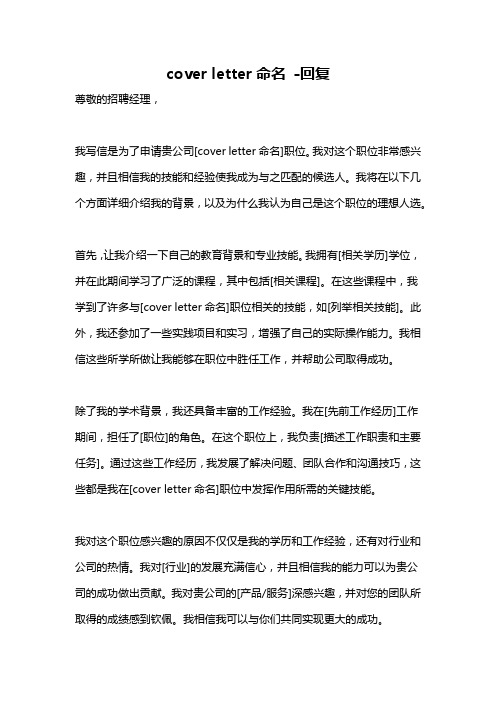
cover letter命名-回复尊敬的招聘经理,我写信是为了申请贵公司[cover letter命名]职位。
我对这个职位非常感兴趣,并且相信我的技能和经验使我成为与之匹配的候选人。
我将在以下几个方面详细介绍我的背景,以及为什么我认为自己是这个职位的理想人选。
首先,让我介绍一下自己的教育背景和专业技能。
我拥有[相关学历]学位,并在此期间学习了广泛的课程,其中包括[相关课程]。
在这些课程中,我学到了许多与[cover letter命名]职位相关的技能,如[列举相关技能]。
此外,我还参加了一些实践项目和实习,增强了自己的实际操作能力。
我相信这些所学所做让我能够在职位中胜任工作,并帮助公司取得成功。
除了我的学术背景,我还具备丰富的工作经验。
我在[先前工作经历]工作期间,担任了[职位]的角色。
在这个职位上,我负责[描述工作职责和主要任务]。
通过这些工作经历,我发展了解决问题、团队合作和沟通技巧,这些都是我在[cover letter命名]职位中发挥作用所需的关键技能。
我对这个职位感兴趣的原因不仅仅是我的学历和工作经验,还有对行业和公司的热情。
我对[行业]的发展充满信心,并且相信我的能力可以为贵公司的成功做出贡献。
我对贵公司的[产品/服务]深感兴趣,并对您的团队所取得的成绩感到钦佩。
我相信我可以与你们共同实现更大的成功。
此外,我有很强的自学能力和持续学习的意愿。
我始终保持对最新技术和行业动态的关注,并通过参加培训和课程来不断提升自己的知识和技能。
我相信这种持续学习的态度是成为一个优秀的专业人士所必需的,也能够帮助我在[cover letter命名]职位中不断进步和提供价值。
总的来说,我相信我的学术背景、工作经验、行业热情和持续学习精神使我成为贵公司[cover letter命名]职位的理想人选。
我非常希望有机会面试并进一步探讨我可以为公司做出的贡献。
感谢您抽出时间阅读我的申请。
期待能够有机会与您进一步交流。
journal of infection的cover letter -回复

journal of infection的cover letter -回复尊敬的《Journal of Infection》编辑部:我谨向您提交了我所完成的研究论文题为“中括号内的内容”。
我希望通过您的期刊发表此研究,因我相信它将对传染病的理解和管理产生积极的影响。
我认为该研究与您的期刊的范围和目标非常吻合,特此针对该研究的重要性和可能对该领域的贡献,提交下面的论文概述。
首先,我想强调中括号内的内容(以下简称为“题目”)的重要性。
[详细描述题目的背景和目的、研究领域的重要性,解释为什么人们对此感兴趣]。
因此,本文的研究目的是[阐明研究的具体目标和问题]。
这一研究不仅填补了[相关领域]的知识空白,而且还有可能为[相关领域]的发展和未来研究提供了新的方向和线索。
在此研究中,我们采取了[详细描述研究设计和方法]。
为了确保数据的可靠性和有效性,我们采用了[详细描述采样方法、数据收集和分析方法]。
通过这些方法,我们能够获取准确和可比较的数据,并对其进行深入的统计分析。
接下来,我想介绍一下我们的研究结果和讨论。
[详细描述研究结果的主要发现]。
这些结果为[相关领域]提供了一系列新的见解和理论基础。
此外,我们还发现了一些[与题目相关的重要结果]。
这些结果对于[解决某个问题、改善医学实践等]具有重要的意义。
最后,我想强调一下题目的研究意义和创新之处。
该研究不仅在方法和结果上具有创新性,还有助于提高我们对[相关领域]的认识和理解。
对此,我们提出了一些[探讨结果和研究领域未来发展方向的建议]。
综上所述,我认为我们的研究结果具有重要的学术和实践意义,能够为《Journal of Infection》的读者做出积极的贡献。
我们希望您能够评估我们的论文,并给予发表的机会。
我们相信《Journal of Infection》的高品质和学术声誉将进一步推动该研究领域的发展。
再次感谢您和您的同事们对我们研究的关注与支持。
期待能够在《Journal of Infection》上发表我们的论文,并为该期刊的发展做出贡献。
- 1、下载文档前请自行甄别文档内容的完整性,平台不提供额外的编辑、内容补充、找答案等附加服务。
- 2、"仅部分预览"的文档,不可在线预览部分如存在完整性等问题,可反馈申请退款(可完整预览的文档不适用该条件!)。
- 3、如文档侵犯您的权益,请联系客服反馈,我们会尽快为您处理(人工客服工作时间:9:00-18:30)。
给一个答复审稿人意见的coverletter,希望对大家有帮助Cover letterManuscript number: BXXXXXKMS Type: ArticleTitle: "XXXX"Correspondence Author: XXXDear Dr. Fay Riordan:Thank you very much for your attention and the referee’s evaluation and comments on our paper BXXXXK. We have revised the manuscript according to your kind advices and referee’s detailed suggestions. Enclosed please find the responses to the referees. We sincerely hope this manuscript will be finally acceptable to be published on XXX.Thank you very much for all your help and looking forward to hearing from you soon.Best regardsSincerely yoursDr. XXXPlease find the following Response to the comments of referees:Response to the referee’s commentsReferee AComment 1: The titania material formed after calcining at 450 oC is not characterized. XRD of these calcined materials should be provided to understand the crystallinity and phase.Response: Thanks for the referee’s kind suggestion. According to his/her advices, X-ray diffractometry spectroscopy (XRD) of the calcined TiO2 film was given in Supporting Information (Figure S1) in this revised version. It illustrated that the hydrothermal synthesized TiO2 materials after calcining at 450 oC is entire anatase, which was confirmed by the X-ray diffractometer with Cu Kα radiation (Rigaku D/ max-2500).Comment 2: The authors must state the mechanical strength of these materials after the removal of PS by calcinations.Response: Thanks for the referee’s suggestion. By a scotch tape peel test, the TiO2 film can’t be stripped from the conducting glass substrate, which indicates that the mechanical strength of as-prepared composite film is strong enough for the fabrication of solar cell devices. The revised details can be found in Line 165-168, page 2.Referee BComment 1: The microtube structure with the size of 500-800 nm cannot only scatter the visible light in the region of 500-800 nm, but also can scatter more efficiently the visible light in the region below 500 nm, and can scatter near infrared light. This point should be clarified in the main text.Response: Thanks for the referee’s kind advice. Just like what the referee said, the microtube network structure can scatter not only visible light but also near infrared light. We added this point in revised manuscript and the detailed revision can be found in Line 194-205, Page 2-3.Comment 2: They described the simulated sunlight as "one-simulating-sunlight condition (AM1.5, 100 mW cm-2)". But in my opinion, it would be better to use the phrase like "AM 1.5 simulated solar light (100 mW cm-2)".Response: Thanks for the referee’s suggestion. "one-simulating-sunlight condition (AM1.5, 100 mW cm-2)" has been changed to "AM 1.5 simulated solar light (100 mW cm-2)" in our revised manuscript. (Line 217, Page 3)Comment 3: They correctly pointed out that the increased ratio of solar energy conversion efficiency by the microtube-network structure was smaller than that estimated from the absorption spectra. It is understandable, considering that a TiO2 porous film was filled with solvent in a device, while that for spectroscopic measurements is filled with air.Response: Thanks for the referee’s good evaluation and kind suggestion. The referee’s explanation is very correct. Light absorptions of TiO2 photoelectrodes are different when they are filled with electrolytes and air, respectively. It is ascribed to that a part of solar light will be absorbed by the electrolytes and also different medium in the porous film will induce the different refractive indices. This is one reason that increased ratio of conversion efficiency by the microtube-network structure was smaller than that estimated from the absorption spectra. We added this point into our revised manuscript and the details can be found in Line 325-330, Page 4.【论坛浏览】【我来说两句】【打印】【大】【中】【小】【关闭】相关评论作者: hxszhy 发布日期: 2007-11-28这里还给一个在某论坛上看到的一个帖子,关于答复审稿人,只是供大家参考:很多人都遇到过回复审稿人意见的时候。
本人曾经因为回复审稿意见不合适而导致拒稿,相当的惨哪!!后来发现回复审稿意见时,除了写清修改内容外,还有一些话是必须要写的。
对审稿人的意见提出不同的看法也应该讲究一定的技巧。
由于这些话的英文都不难写,所以我直接写成中文表述,觉得有用的虫友自己翻译吧。
首先,不论审稿人提了什么意见,你在回复的时候,第一句话一定要说:“谢谢您的建议,您的所有建议都非常的重要,它们对我的论文写作和科研工作都具有重要的指导意义!!”其次,在回复信的结尾最好写上“再次谢谢您的建议,希望能够从您哪里学到更多的知识。
”这句话最好用黑体,要显眼。
再次,如果审稿人提的意见你暂时无法做到(比如,要你增加实验或改进实验等)。
那么,为了论文尽快发表,你必须拒绝这样的要求。
但是,你不要摆出一大堆理由来证明这个意见是不好实现的。
你应该说:“谢谢您的建议,它非常的重要,由于您的建议,我发现了我目前工作中的不足之处,我会在以后的工作中按照您的建议提高科研水平,取得更多成绩!”这样就委婉的拒绝了评审意见,又让评审人觉得你很看重他的意见。
